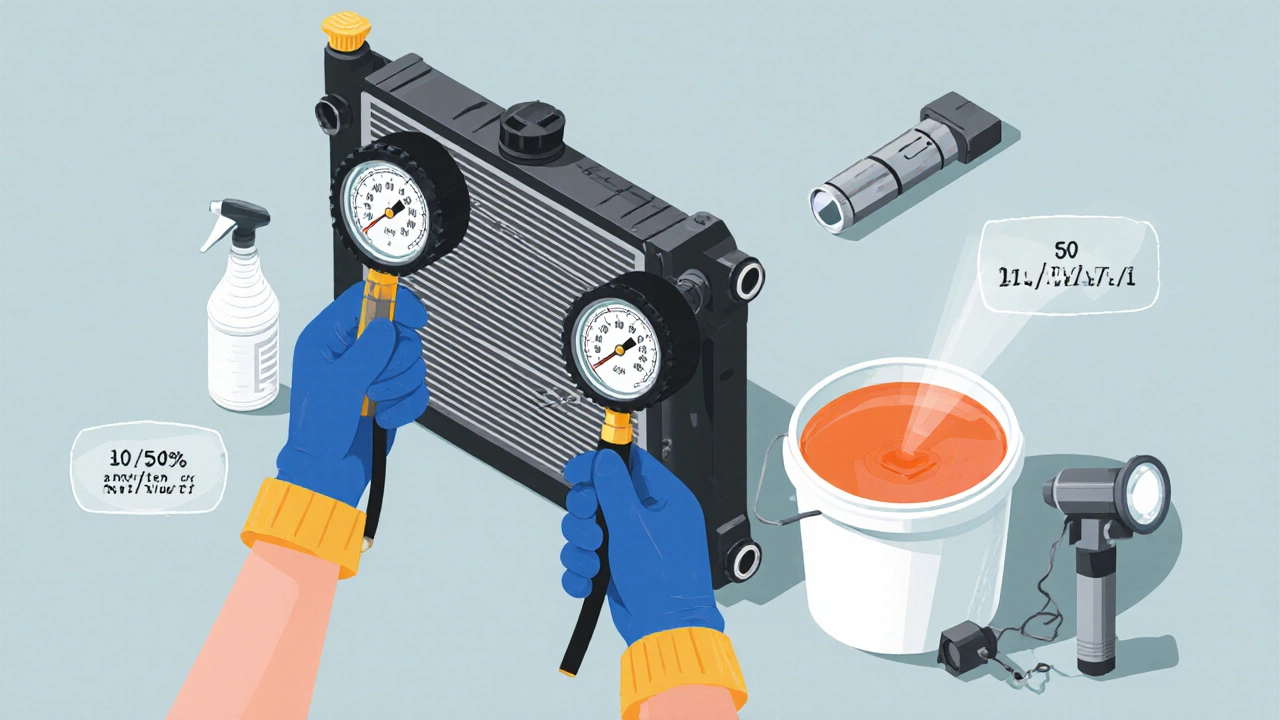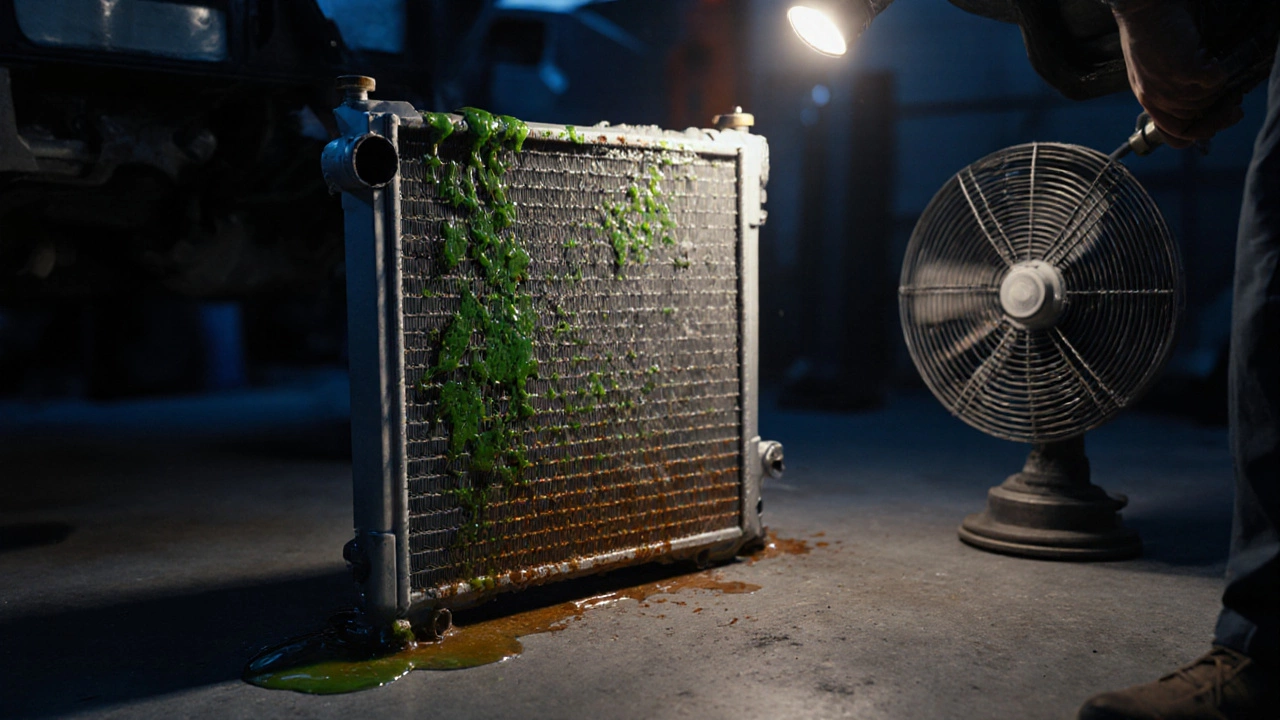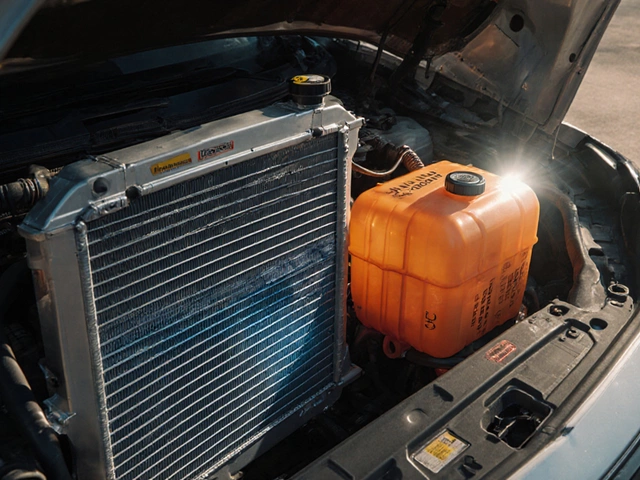Radiator Health Checker
Enter your radiator conditions and click "Check Radiator Health" to get a diagnostic report.
Key Takeaways
- Regular radiator inspection stops costly overheating problems.
- All you need is coolant, a pressure tester, and a flashlight.
- Check coolant level, look for leaks, test the pressure cap, and confirm fan operation.
- Typical issues are leaks, blocked fins, and a stuck thermostat.
- Follow the troubleshooting steps if the temperature gauge spikes.
When it comes to keeping your car running smooth, Radiator is a heat‑exchange component that transfers heat from the engine coolant to the air passing through its fins. It sits at the front of the engine bay and is vital for preventing the engine from overheating. If you skip regular checks, a tiny crack or a clogged fin can turn a simple drive into a roadside nightmare.
Before you start, gather three basics: a clean bucket, a garden‑style pressure tester, and an infrared thermometer (or a simple temperature gun). You’ll also be dealing with a few other key players:
- Coolant a mixture of water and antifreeze that absorbs engine heat.
- Thermostat a valve that opens at a set temperature to let coolant flow.
- Pressure cap maintains the system’s boiling point by sealing the coolant chamber.
- Radiator hoses rubber conduits that carry coolant in and out of the radiator.
- Radiator fan electrical or belt‑driven fan that draws air through the fins.
- Temperature gauge the dashboard needle that alerts you to overheating.
- Overflow tank a reservoir that catches expanding coolant and feeds it back.
Why a Radiator Check Matters
Even the best‑engineered radiators can fail if dust builds up, coolant degrades, or a hose leaks. An overheating engine can quickly seize, warp the cylinder head, or even blow a head gasket-repairs that run into three‑figure territory. A quick visual check or a pressure test takes five minutes but can save you hundreds of pounds.

Step‑by‑Step Guide to a Complete Radiator Inspection
- Coolant Level Check
- Park on level ground, let the engine cool for at least 30 minutes.
- Open the hood and locate the overflow tank. The tank has “MIN” and “MAX” lines.
- If the level is below MIN, top up with a 50/50 mix of distilled water and antifreeze that matches your vehicle’s specifications.
- Inspect the Radiator Core
- Look at the front and rear of the radiator for green, orange, or brown stains-these indicate leaking coolant.
- Use a flashlight to peer between the fins for corrosion or broken tabs.
- Examine Hoses and Connections
- Press each hose gently; a soft spot may mean it’s swelling from heat.
- Check clamps for tightness. Loose clamps can cause slow leaks.
- Test the Pressure Cap
- Remove the cap when the engine is cold. Look for broken seals or rust.
- If you have a pressure tester, pressurise the system to the cap’s rated psi (usually 15‑16psi). The cap should hold without dropping pressure.
- Run a Leak Detection Test
- Start the engine, let it reach operating temperature, then spray a mixture of soap and water on the radiator and hoses.
- Bubbles mean air is escaping-pinpoint the exact spot.
- Check the Radiator Fan
- With the engine running, watch the fan spin. It should engage automatically around 90°C (194°F) or when you press the AC.
- If it doesn’t spin, listen for a humming motor-sometimes the fan clutch is stuck.
- Monitor the Temperature Gauge
- After the engine warms, glance at the gauge. It should settle in the middle‑range zone.
- Any sudden rise past the normal limit indicates a problem that needs immediate attention.
Common Radiator Problems and What to Look For
Even after a thorough check, you might encounter recurring issues. Here are the most frequent culprits:
- External Leaks: Typically found at hose connections, the pressure cap, or the tank. Look for wet spots or dried coolant deposits.
- Internal Leaks: Coolant mixing with oil or steam from a blown head gasket. A sweet, milky oil smell often gives it away.
- Blocked Fins: Dust, pollen, or road grime can choke airflow. A soft brush or compressed air clears them without bending the fins.
- Stuck Thermostat: If the engine runs too cool, the thermostat may be closed; if it overheats quickly, it might be stuck open.
- Corroded Radiator Core: Over time, the metal can rust, especially if the coolant isn’t changed regularly.
Pro Tips to Keep Your Radiator Healthy
- Use distilled water in your coolant mix to avoid mineral deposits.
- Flush the system every 30,000km (or every two years) to remove sludge.
- Replace the pressure cap when you replace the coolant; caps lose elasticity over time.
- Keep the fan shroud clean; a dirty shroud reduces airflow by up to 20%.
- Consider a radiator flush kit that includes a strong cleaning solution and a pump for deeper cleaning.

Method Comparison
| Method | Tools Needed | Typical Time | Accuracy |
|---|---|---|---|
| Visual + Soap Test | Flashlight, soap‑water mix | 5‑10min | Good for surface leaks |
| Pressure Tester | Garden‑style pressure tester | 10‑15min | Excellent - finds hidden leaks |
| Infrared Thermometer Scan | IR gun | 3‑5min | Useful for spotting hot spots |
Troubleshooting Overheating Scenarios
If your temperature gauge climbs above the normal range, follow this quick decision tree:
- Check coolant level - low? Top up and look for leaks.
- Listen for the fan - not running? Inspect fan relay or clutch.
- Feel the radiator - unusually hot on one side? Possible blockage.
- Pull a diagnostic code - many modern cars log a “coolant temperature sensor” fault.
Address the first failing point you discover; most overheating problems are resolved by fixing a leak or getting the fan back in action.
Frequently Asked Questions
How often should I check my radiator?
A quick visual check and coolant level test every month is ideal. A full pressure test and fan inspection should be done at least once a year or before long trips.
Can I use water instead of coolant?
Water alone will boil at a lower temperature and offers no corrosion protection. A 50/50 mix of antifreeze and distilled water is the safest choice for most vehicles.
What does a stuck thermostat feel like?
If the engine never reaches its normal operating temperature, the thermostat is likely stuck closed. Conversely, if the engine runs cold even after a long drive, the thermostat may be stuck open.
Is a radiator fan that only runs with AC normal?
Many modern cars have an electric fan that turns on only when the temperature hits a certain threshold or when the AC is active. If the fan never spins when the engine is hot and the AC is off, the fan relay or temperature sensor could be faulty.
Why does my radiator leak only when the car is hot?
Heat causes metal to expand, revealing cracks or worn seals that stay tight when cold. Look for coolant drips on the ground after a hot run; the source is usually a hose clamp or the pressure cap.
